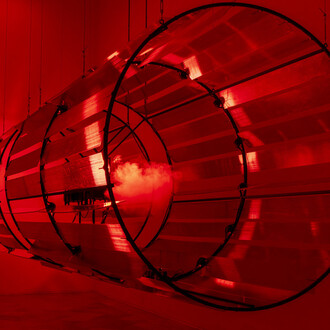In waste products [children] they recognize the face that the world of things turns directly and solely to them. In using these things, they do not so much imitate the works of adults as bring together, in the artefact produced in play, materials of widely differing kinds in a new, intuitive relationship.
(Walter Benjamin)
The body—sculptural, biological, or conceptual—does not exist to remain still. As a body, it must relate to other bodies. Similarly, the image—understood both as a visible body and as a product of imagination and theoretical exercise—always operates in a performative and relational manner. Think, for instance, of religious imagery and the performative use of what we call “images,” referring here to the Catholic tradition of carving or painting sacred figures. These are images made to be put into circulation, meant to make us move around them. This brings up a first question: what happens when an image insists on moving? This inquiry, sparked in dialogue with the context surrounding this gallery—the exhibition opens during the Cruces de Mayo in Seville— activates both the works of the invited artists and our own position—perhaps closer to that of performers within a theatrical space than mere spectators.
The exhibition explores the inherent tension between the sculptural as a stable form and its drift toward action, transit, and performativity. What is proposed here is not a taxonomic classification, but a revisiting of the classic dilemma between stillness and motion: a composition of bodies in space through a series of notes—understood as open-ended gestures toward sensory, perceptual, or even musical dialogue. To do so, the exhibition gathers a diverse group of artists whose practices, far from pursuing formal or thematic unity, share a sensitivity toward the porous, the transitory, and the displaced. These are artistic practices that emphasize the centrality of the body in all its possible meanings; that understand materials as active forms of thought; that systematically question traditional categories such as object, installation, action, or document; and that reveal how the sculptural and the somatic can hold movement even in their apparent stillness. Rather than reaffirming sculpture as a closed volume or monumental presence, the works presented here unfold as unstable forms: mobile presences, fleeting traces, masks, fabrics, choreographies of objects and words that activate the gallery space. There is no central core here, no evolutionary sequence, but a constellation of practices driven by the desire to think about the image through its ability to transform, to be affected, and to affect us in turn.
The project is structured around three conceptual axes—not as isolated compartments, but as intertwined and complementary reading perspectives—through which the works can be approached from multiple angles: Transits, popular imagery; Gleaners, galleries; and Itinerant theatres, transits. As a performative gesture of closure—or rather, as an epilogue—the gallery’s courtyard has been activated. This gesture serves as a symbolic retribution for the offering of the space—understood from the outset not as a closed gallery, but as a construction site in progress, where collective imagination can give rise to new ways of inhabiting the city through the commons. Finally, throughout the exhibition period, a series of activations will take place, expanding the scope of the show and deepening the themes it explores.
(Text by Enrique Fuenteblanca)













